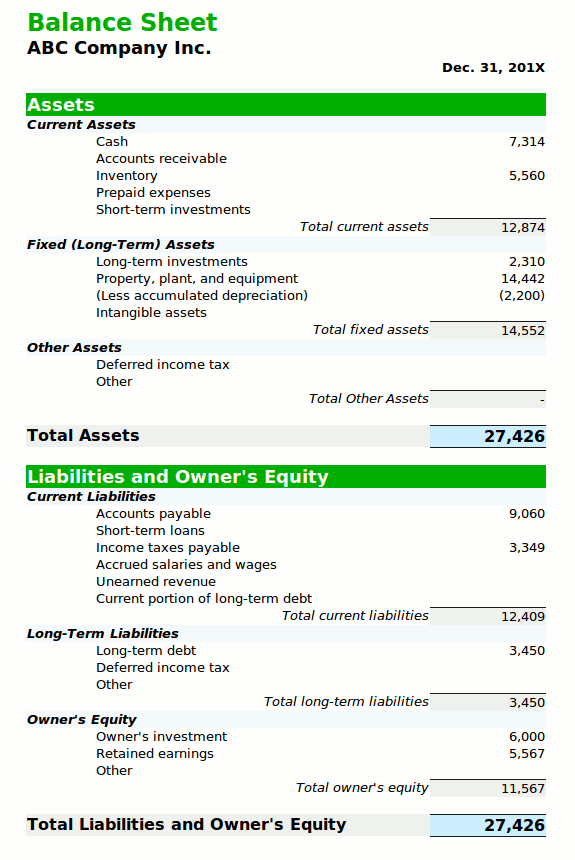A standard balance sheet has three parts: assets, liabilities, and ownership equity; Asset = Liabilities + Equity.
Learning Objectives
Identify the basics of a balance sheet.
A standard balance sheet has three parts: assets, liabilities, and ownership equity; Asset = Liabilities + Equity.
Identify the basics of a balance sheet.
In financial accounting, a balance sheet or statement of financial position is a summary of the financial balances of a sole proprietorship, a business partnership, a corporation or other business organization, such as an LLC or an LLP. Assets, liabilities and ownership equity are listed as of a specific date, such as the end of its financial year. A balance sheet is often described as a “snapshot of a company’s financial condition. ” Of the four basic financial statements, the balance sheet is the only statement which applies to a single point in time of a business’ calendar year.
A standard company balance sheet has three parts: assets, liabilities, and ownership equity. The main categories of assets are usually listed first, and typically in order of liquidity. Assets are followed by the liabilities. The difference between the assets and the liabilities is known as “equity. ” Equity is the net assets or net worth of the capital of the company. According to the accounting equation, net worth must equal assets minus liabilities.

A balance sheet summarizes an organization or individual’s assets, equity, and liabilities at a specific point in time. We have two forms of balance sheet. They are the report form and the account form. Individuals and small businesses tend to have simple balance sheets. Larger businesses tend to have more complex balance sheets, and these are presented in the organization’s annual report. Large businesses also may prepare balance sheets for segments of their businesses. A balance sheet is often presented alongside one for a different point in time (typically the previous year) for comparison.
A personal balance sheet lists current assets, such as cash in checking accounts and savings accounts; long-term assets, such as common stock and real estate; current liabilities, such as loan debt and mortgage debt due; or long-term liabilities, such as mortgage and other loan debt. Securities and real estate values are listed at market value rather than at historical cost or cost basis. Personal net worth is the difference between an individual’s total assets and total liabilities.
A small business balance sheet lists current assets, such as cash, accounts receivable and inventory; fixed assets, such as land, buildings, and equipment; intangible assets, such as patents; and liabilities, such as accounts payable, accrued expenses, and long-term debt. Contingent liabilities, such as warranties, are noted in the footnotes to the balance sheet. The small business’s equity is the difference between total assets and total liabilities.
Guidelines for balance sheets of public business entities are given by the International Accounting Standards Board and numerous country-specific organizations/companies.
Balance sheet account names and usage depend on the organization’s country and the type of organization. Government organizations do not generally follow standards established for individuals or businesses.
If applicable to the business, summary values for the following items should be included in the balance sheet: Assets are all the things the business owns, including property, tools, cars, etc.
1. Current assets
2. Non-current assets (fixed assets)
Regarding the items in equity section, the following disclosures are required:
Income statement is a company’s financial statement that indicates how the revenue is transformed into the net income.
Describe the different methods used for presenting data in a company’s income statement.
Income statement (also referred to as profit and loss statement [P&L]), revenue statement, a statement of financial performance, an earnings statement, an operating statement, or statement of operations) is a company’s financial statement. This indicates how the revenue (money received from the sale of products and services before expenses are taken out, also known as the “top line”) is transformed into the net income (the result after all revenues and expenses have been accounted for, also known as “Net Profit” or the “bottom line”). It displays the revenues recognized for a specific period, and the cost and expenses charged against these revenues, including write offs (e.g., depreciation and amortization of various assets) and taxes. The purpose of the income statement is to show managers and investors whether the company made or lost money during the period being reported.
The important thing to remember about an income statement is that it represents a period of time. This contrasts with the balance sheet, which represents a single moment in time.

.
Bottom line is the net income that is calculated after subtracting the expenses from revenue. Since this forms the last line of the income statement, it is informally called “bottom line. ” It is important to investors as it represents the profit for the year attributable to the shareholders.